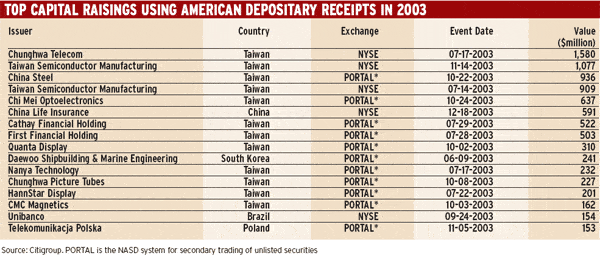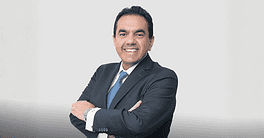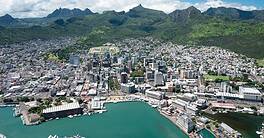ADRs Look Set To Become the Capital-Raising Tool of Choice
With interest rates poised to rise later this year, ADRs are expected to supplant convertible bonds as the preferred instrument for emerging-market issuers.

|
|
managing director of depositary receipt services at Citigroup |
Capital-hungry companies in emerging Asia rushed to market with issues of American depositary receipts late last year in anticipation of improving economic prospects.
The surge could signal the beginning of a trend that is likely to accelerate in 2004, analysts say. Asian issuers accounted for 96% of the capital raised using ADRs last year, according to JPMorgans ADR group.Technology, telecom and financial services companies were the biggest issuers.
Taiwan Semiconductor Manufacturing led the parade of Asian issuers, with nearly $2 billion raised in two ADR offerings.Taipei-based Chungwa Telecom, raised $1.58 billion.
Eight of the 10 largest ADR capital raisings in 2003 were by Taiwanese firms.The other two issuers in the top 10 were also from Asia: China Life Insurance and Daewoo Shipbuilding & Marine Engineering of South Korea.
The throng of Taiwanese companies that tapped the US equity market last year was the driving force behind a 32% increase to $9.5 billion in capital raised using ADRs, according to New York-based Citigroup.The surge in capital raising in the latter part of 2003 indicates a trend thats going to continue, says Sanjeev Nanavati, managing director of depositary receipt services at Citigroup.
Reflecting the rally in global equity markets that began in the second quarter of 2003,and the apparent end of the SARS virus crisis in Asia, 99% of the capital raised via ADRs last year occurred after April.Many Taiwan issuers favored convertible bonds last year, but with the prospect of higher interest rates ahead, we believe ADRs will be the preferred capital-raising tool for 2004,Nanavati says.
Taiwanese companies are very quick and nimble, Nanavati says.While a few convertible-bond issues are still coming to market, this is likely to change suddenly if interest rates begin to rise, he adds.
Emerging Economies Dominate ADR Market
New issues are also likely to come from other emerging markets with a big appetite for capital, including India and Russia, Nanavati says.A number of privatizations are in the works in India, where the local stock market rose 74% in US dollar terms in 2003. Indian companies will want to tap the ADR market when their share prices are high, so they cannot be accused of selling out to foreigners at a bargain-basement price, according to market participants. The companies are likely to come to market after the national elections, expected to be held in the next few months.
Meanwhile, developed-market European issuers were largely absent from the ADR capital- raising arena in 2003. This is largely because their home markets are quite deep, making it less necessary to go abroad for funds, analysts say.
Not only did Asian companies dominate the market for ADR capital raising last year, but they also were the most actively traded issues.The 11% growth in the value of ADRs traded in 2003 was paced by a 61% surge in trading of ADRs of Asian-based companies,while the trading value for Western European companies declined slightly.
The momentum in ADR activity weve seen in the past few months accentuates a pattern that has continued over time: Investors in ADRs and non-US shares continue to seek value in geographic and industry diversification, Nanavati says. ADRs continue to provide US investors with opportunities to own some of the worlds most-attractive companies.
Although there were fewer new programs established last year than in 2002, Asia represented a bright spot, with half of all new programs, says Akbar Poonawala, managing director and head of global equity services at Deutsche Bank. The marked pick-up in the establishment of new programs in the last quarter of 2003 is also noteworthy, he says.
Growing investor confidence and improving economic conditions will sustain interest in ADRs, says Christopher Sturdy,managing director and head of Bank of New Yorks ADR division.Asia will continue to be a strong contender in 2004, with technology companies and manufacturers tied to technology remaining active in the capital-raising market, Sturdy says.When the equity market was closed to them, many of these companies went to convertible bonds and relied on cash holdings,he says.As soon as the equity window opened in the second half of last year, they came to market as quickly as they could.
Unlike the last big rush by technology issuers in the late 1990s,many of these firms are now profitable, Sturdy says. This suggests that the trend of rising capital raisings will be sustainable, he says.
In India, the privatization of infrastructure and other state-owned enterprises will be augmented by offerings by technology and service-sector companies,Sturdy says.Business- process outsourcing and software companies are likely to come to market this year, he says
Central and Eastern Europe also could be an active region in 2004, tied in part to the accession of 10 new countries to the European Union, according to Sturdy. Russian manufacturing and oil-service companies are expected to offer new ADR issues, and Poland will come back to the market, he says. Poland has a strong domestic investor base, as well, but some secondary-market ADR deals are expected.
Meanwhile, the documentation is being dusted off for increased mergers and acquisitions in Western Europe and for European companies seeking to acquire US firms, and some of these transactions will be financed using ADRs, Sturdy says.
Bank of New Yorks composite ADR index rose 30.5% in 2003, led by a 61% surge in Latin American-based ADRs,reflecting a rebound in Brazil and Argentina.
A total of 82 new ADR programs from companies based in 25 countries were established in 2003, down from 145 new programs from 34 countries in 2002.
The number of exchange-listed depositary-receipt programs declined sharply last year,but this was offset to some extent by a pick-up in non-listed programs.
Only four new listed ADR initial public offerings came to market last year:Telkom South Africa, Chungwa Telecom, China Life Insurance, and South Korea-based Webzen, which distributes online games.

New York Loses Its Luster
Some market participants say foreign issuers are reluctant in many cases to list on the New York Stock Exchange or Nasdaq because of the need to comply with Sarbanes-Oxley accounting requirements. Foreign corporate executives are afraid that if they sign their name to a report and it turns out to have an inadvertent error, they will go to jail, according to one market participant. As a result, he says,many foreign issuers prefer to stick to Level-1 ADR programs in the over-the-counter market, where they are relieved from financial disclosures using US accounting standards.
Patrick Colle, London-based global head of JPMorgans ADR group,says the low level of newly listed IPOs last year was mainly related to the state of the capital markets and not accounting issues. Sarbanes-Oxley wont prevent issuers with a strong business rationale from tapping the US market, he says.The brighter news as we finished 2003 was a definite rebound in ADR capital raising that will continue to pick up in 2004, with Asia leading the pack. Chinese, Taiwanese and South Korean companies will remain active issuers this year, he says.
By Gordon Platt



